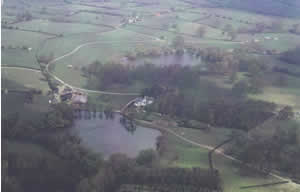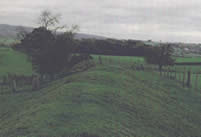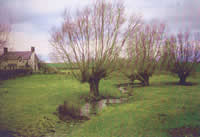
Lymore Landscape

The landscape of Lymore is uniquely beautiful. A farmed landscape for the most part, with some scattered woodland, the Lymore Estate is an important feature of the Marches countryside along the Welsh/English border. As a result of its historical and geographical importance, this area has been the subject of a major Heritage Landscape Management Plan.
This web page aims to give some insight into the
main features of the Lymore Landscape.
The Ffridd
The Iron Age Camp at the summit of this area of rough hillside is an ancient
feature which once formed part of a medieval park. Its form is still visible
today, but the original camp is overlaid by the pattern of large fields
and scattered woodland. Butcher's Wood on the Ffridd was in existence
by 1785, but enlarged by 1828.
Town Hill
This was part of the commons of the burgesses of Montgomery until 1787,
when it was acquired by Lord Powis.
Lymore Park
Lymore Park is a historical patchwork of features from many different
eras.
Ridge and furrow field scars, medieval park features, evidence of brick-making
activity, road features, woodland plantations, possible settlement evidence
and pools all contribute to the rich and interesting variety of the Lymore
landscape.
Offa's Dyke Famous as the ancient boundary between England and
Wales, much of the line of Offa's Dyke was incorporated into the modern
national boundary in the Act of Union in 1536.
Cae Mwgal This was a single holding in the 16th Century, owned
by the fraternity of Montgomery, bounded by an area of open field called
Wickey Field.
Chirbury Hall This listed building is on the site of the original
priory. The grounds contain the remains of a late 16 Century dovecote.
Chirbury Kings Orchard The reputed site of Aethelfaed's burgh of
Cyribyrig, founded in 915, is an embanked enclosure to the west of Chirbury
village. Archeological excavations have unearthed no sign of a palisade,
nor any evidence of Saxon or medieval pottery, suggesting that this enclosure
was probably never permanently occupied, or that it may not have been
completed.
Walcot The Herbert family appear to have been in full control of Walcot
by the close of the 16th Century. The open field system here was dismantled
between 1536 and 1600.
Winsbury In 1785, the village of Winsbury consisted of just three houses
and the farm. Ridge and furrow features are still visible around the area
called Town Field. Earthworks nearby suggest a deserted village site.
Roundhill The remains of ridge and furrow are visible to the north
and west of Roundhill (Rownall). Several 'squatters' cottages used to
line the lane and along Offa's Dyke in this region, but these seem to
have disappeared by 1828, or to have been upgraded into farm steads.
Hockleton
Hockleton is overlooked by a motte and bailey arrangement.
Dudston West and East Dudston Farms face one another at this site, which
was once a larger village. Ridge and furrow evidence, plus the route of
the pre-turnpike road are still visible. Detailed survey work suggests
that the ridge and furrow pattern is not continuous through the line of
Offa's Dyke, therefore not proving the existence of an eighth century
farming community here.
Timberth
It is thought that Great Moat Farm was originally the manor of Timberth.
This was a dispersed settlement and only sections of it survive according
to its original form.
Sidnal
The original enclosure at what is now Sidnall Farm, is overlaid by some
sections of visible ridge and furrow.
Gwarthlow
Gwarthlow is the only motte in the Lymore area not specifically connested
to a present day farmstead. It is however, the largest, even though cultivation
has taken away most of its ditch and all of the bailey.
The Ditches
The Ditches were originally Roman marching camps, intersected now
by Offa's Dyke at Brompton Mill. They appear as crop marks on aerial photographs.
 |
 |
| home about lymore montgomery castle lymore landscape contact & links |